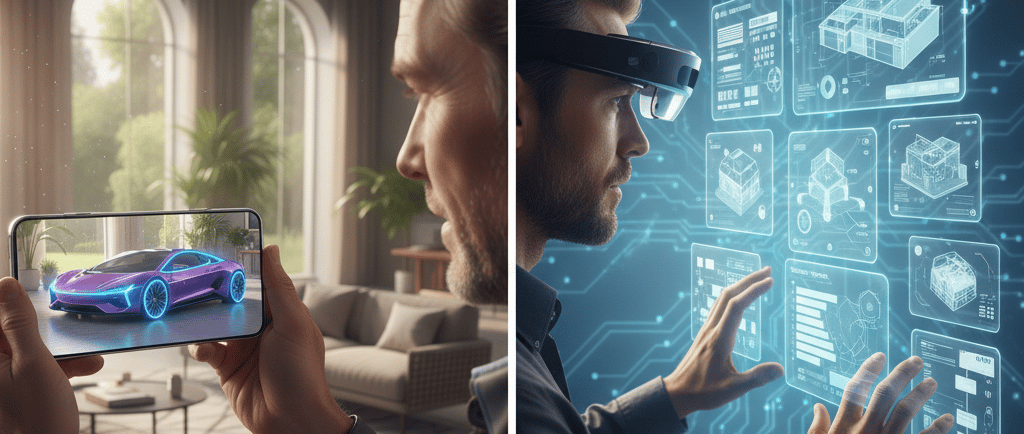“Difference Between Augmented Reality (AR) and Mixed Reality (MR)”, with title, description, image prompt, and headings
Explore the key differences between Augmented Reality (AR) and Mixed Reality (MR). Learn how each technology works, their applications, and how they shape the future of immersive experiences.


🌐 Blending Realities: The Key Differences Between Augmented Reality (AR) and Mixed Reality (MR)
Introduction: Defining the Spectrum of Immersive Tech
In today's digitally driven world, technologies that blur the lines between the physical and virtual—collectively known as Extended Reality (XR)—are revolutionizing how businesses and consumers interact. While Augmented Reality (AR) and Mixed Reality (MR) both involve blending digital content with the real world, they occupy distinctly different places on the immersion spectrum.
Understanding this difference is critical for businesses, including immersive media specialists like 360 vr photography, when deciding which technology offers the right solution for specific client goals.
Let's dissect the core differences between these two fascinating technologies.
What is Augmented Reality (AR)? 📱
Augmented Reality enhances your existing reality by overlaying static or animated digital content—such as 3D models, text, or graphic overlays—onto your view of the physical world, typically via a mobile device screen (smartphone, tablet) or lightweight AR glasses.
The Key Limitation: The digital elements in AR generally do not interact deeply with the physical objects in the environment. They appear on the real world but are not of the real world.
Examples of AR in Action:
Retail: The IKEA Place app allows you to visualize furniture in your home's actual space, seen through your phone camera.
Entertainment: Filters on platforms like Snapchat and Instagram that overlay digital masks or effects onto a user's face.
Gaming: Pokémon GO, where digital characters are anchored to real-world locations.
Key Features of AR:
Hardware: Highly accessible, typically uses mass-market devices like smartphones.
Interaction: Limited or no interaction between the digital element and the physical environment.
Purpose: To enhance or add contextual information to the user's perception of reality.
What is Mixed Reality (MR)? 👓
Mixed Reality goes a significant step further than AR. It is a powerful blend of real and virtual elements where both can interact with and influence each other in real time.
MR devices use advanced spatial mapping and depth-sensing cameras to understand the physical environment. This allows virtual objects to be spatially anchored and react to real-world objects—like a digital avatar walking behind a physical desk or a holographic blueprint remaining fixed to a real wall.
The Key Distinction: MR creates a co-existing environment where the user can manipulate and engage with virtual elements as if they possess real physical presence.
Examples of MR in Action:
Engineering/Design: Using the Microsoft HoloLens to project a holographic 3D model of a new machine onto a real factory floor, where engineers can walk around it, point to parts, and virtually dismantle it using hand gestures.
Education: Interactive learning where virtual objects obey the laws of physics imposed by the real room.
Remote Collaboration: An offsite expert can see a real technician's environment and draw digital instructions that appear anchored to the real machinery being worked on.
Key Features of MR:
Hardware: Requires advanced, dedicated headsets (e.g., Microsoft HoloLens, Magic Leap) with depth sensors and greater processing power.
Interaction: Seamless, real-time interaction between physical and virtual elements.
Immersion: High level of immersion and realistic digital presence within the real environment.
AR vs. MR: The Reality Spectrum
The easiest way to differentiate is by focusing on the level of interaction and integration.
FeatureAugmented Reality (AR)Mixed Reality (MR)InteractionDigital content is overlaid; limited interaction with real objects.Digital and real objects interact and co-exist (e.g., a virtual ball bounces off a real wall).HardwareSmartphones, Tablets, Simple AR Glasses.Advanced MR Headsets (HoloLens, Magic Leap, Meta Quest 3/Pro).ImmersionModerate (Reality is central, digital is supplementary).High (Digital elements feel truly present and spatially anchored).PurposeTo enhance the real world with contextual visuals and data.To seamlessly merge the physical and virtual for complex, realistic experiences.AccessibilityHigh (Mass-market consumer).Moderate/Low (Currently focused on Enterprise/Industrial use).
Real-Life Applications & The Power of Integration
Both technologies deliver revolutionary solutions, but their application targets are different:
AR in Retail: Customers can quickly try products virtually before buying, increasing sales conversion.
MR in Industry: Engineers can visualize complex machinery and make real-time, gesture-based design changes on a holographic model, speeding up prototyping.
AR in Education: Interactive learning with 3D content overlaid on a textbook via a tablet.
MR in Healthcare: Surgeons can visualize complex patient data or organs as 3D holograms anchored to the operating table during an operation.
Conclusion: The Bridge vs. The Integration
While both Augmented Reality (AR) and Mixed Reality (MR) expand our perception of the world, they do so from different points on the technology spectrum.
AR is the Digital Overlay—it enhances the real world by adding digital elements to your screen.
MR is the Full Integration—it actively blends both worlds, allowing real-time interaction between real and digital objects.
As technology continues to evolve, these distinctions will define how enterprises use immersive media to train, design, market, and revolutionize their businesses.
This guide is now ready for your professional blog! Would you like me to draft some key questions that can be used to determine whether a client needs an AR or an MR solution?
Contact 360 vr photography
Website: 360vrphotography.com and 360vrphotography.in
Contact Number: 9920322366
Name: Viral Gala
